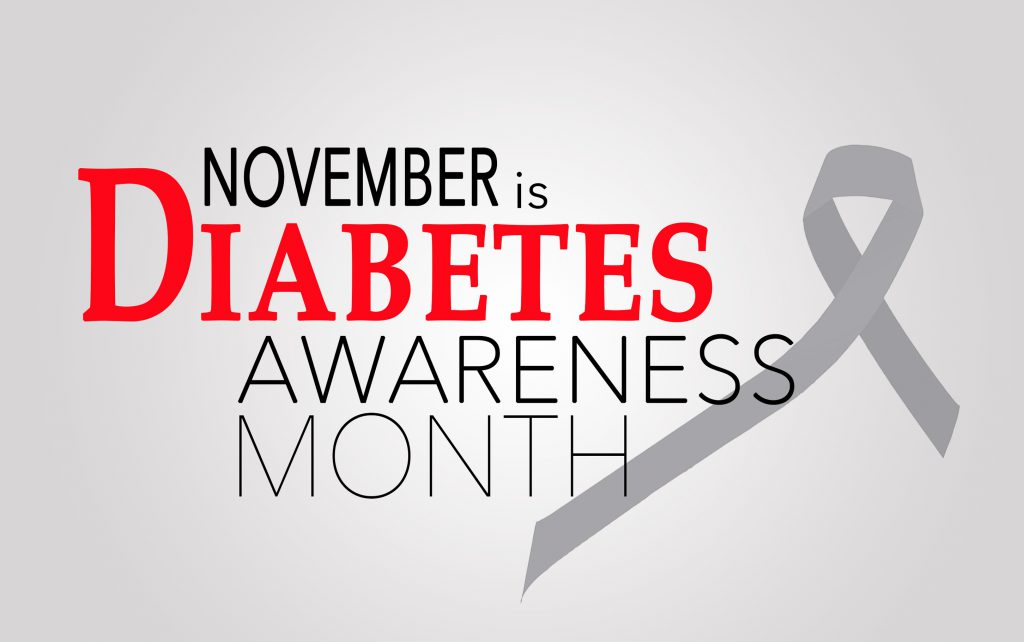
Because of the World Diabetes Day on 14.11 the first blog post will be about diabetes in general, the consequences of the disease and the first progress towards precision medicine.
Diabetes
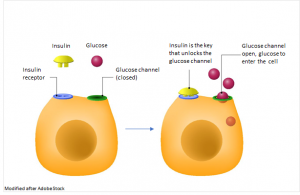 In a healthy person carbohydrates are degraded by the digestive system to glucose and get through the intestinal wall into the blood.1 The hormones insulin and glucagon are responsible for the control of the blood sugar level so the concentration of glucose in the blood.1 Insulin is formed in the so-called beta cells of the pancreas and transports glucose from the bloodstream into the cells.1 Through a process called glycolysis, energy (ATP) is extracted through degradation of glucose.1 The sugar is therefore an important energy source for the brain or the red blood cells for example.1
In a healthy person carbohydrates are degraded by the digestive system to glucose and get through the intestinal wall into the blood.1 The hormones insulin and glucagon are responsible for the control of the blood sugar level so the concentration of glucose in the blood.1 Insulin is formed in the so-called beta cells of the pancreas and transports glucose from the bloodstream into the cells.1 Through a process called glycolysis, energy (ATP) is extracted through degradation of glucose.1 The sugar is therefore an important energy source for the brain or the red blood cells for example.1
In the metabolic disease diabetes mellitus this natural process is disturbed resulting in a permanently increased concentration of blood sugar, also called hyperglycemia.2 Due to the different causes the disease was divided into two main groups. Type 1 diabetes is based on an insulin deficiency which is through a destruction of the beta cells by the own immune system.2 As a result of this autoimmune reaction insulin can no longer be formed.2 This type is relatively rare with a proportion of 5%.2,3 Type 2 diabetes is based on an insulin resistance.2 That means insulin can be produced but the secretion oft he hormone is disturbed.2 In addition to genetic predisposition lifestyle plays a central role.2 As a result this form occurs mainly in older age.2

Epidemiology
Worldwide there are 425 million people living with diabetes, accounting for 8.8% of all 20-79 year olds.4
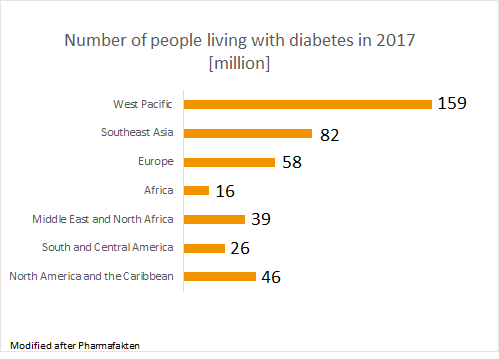
In Germany, the number of diabetics is about 7.6 million (as of 2017).5 Daily, 1,000 new cases are added6 leading to an increase up to 20 million in the next few years.7 Worldwide experts predict 629 million victims until 2045.3
Secondary diseases
The main problem is that diabetes is associated with a variety of secondary diseases. In the long term the metabolic disorder affects kidneys, nerves, retina and blood vessels.8 People with diabetes run a higher risk of strokes and heart attacks.8 Thus, 50% of patients with diabetes die from cardiovascular diseases.6 In addition it has been shown that life expectancy is significantly reduced in patients with diabetes and cardiovascular diseases.9 Studies also reveal a link to neurological disorders. The risk of a diabetic suffering from dementia is about 2.5 times higher than of a healthy person.10
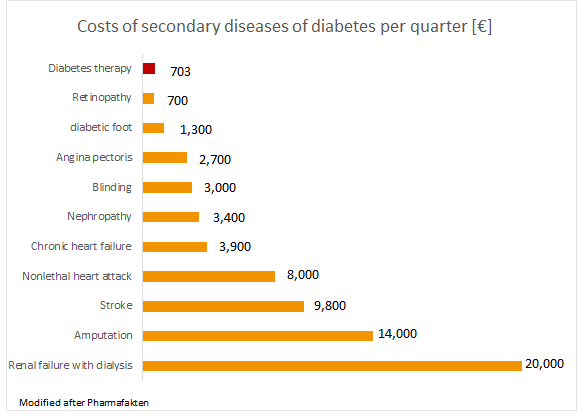
These secondary diseases are also reflected in the costs of health care. They went up to 48 billion euros in 2009, 24% more than in 2000.11 This also becomes clear from an example calculation of a patient: If the diabetes therapy costs about 700 euros per quarter, the resulting complications for example for an amputation costs 14,000 euros per quarter.8
Every day 50,000 amputations, 2,000 cases of blinding and 2,300 cases of renal insufficiency are caused by diabetes.8
The metabolic disease is also responible for more deaths than previously thought. A first study concerning with such a calculation in 2017 revealed 174,627 deaths in 2010 due to diabetes.12 This accounts for 21% of all deaths in Germany.12 Worldwide, 5,1 million people died in 2013, making it to one of the top 10 causes of mortality.12
Recent advances
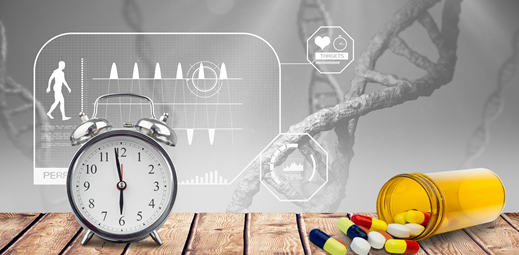
Recent advances in medicine and an even better understanding of the molecular properties of diseases can also been observed in this area. So it is now known that in type 1 diabetes the predisposition plays a certain role.13 Meanwhile a variety of genes have been discovered showing a connection to the development of the disease.13 In addition, researchers have reworked the classification of the disorder.14 After evaluation of 15,000 data in consideration of for example age, BMI or long-term blood glucose level there are five different types of the disease.14 This creates new possibilities of therapy going in the direction of precision medicine. cked0 List T
Personalized medicine
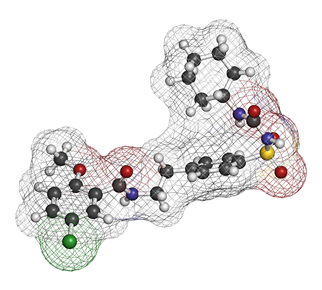
Succes has already been achieved in the field of personalized medicine this year. The drug glibenclamid, which causes huge side effects in the therapy of type 2 diabetes, was first recommended for the treatment of neonatal diabetes.15 This genetic disease is relatively rare with an incidence of 1:100,000.16
In the system of blood sugar ATP-sensitive potassium channels play an important role. These transmembrane proteins consist of two rings, each with four subunits.17 Each subunit is encoded by one gene – KCNJ11 and ABCC8. If the blood sugar level drops meaning the concentration of glucose in the blood, less energy can be produced in the cells.18 The channel is open.18 On the other hand, if the concentration increases, glucose enters the cells, energy (ATP) can be formed and the channel is closed.18 This causes a depolarization and calcium channels gets open. Due to thhe influx of calcium ions into the cell, insulin is secreted, so released from the cells into the bloodstream.18
In the case of neonatal diabetes, there is a mutation in one of the coding genes of the potassium channels. The beta cells are able to produce insulin, but it can’t be secreted because the channel is always open due to the mutation. The depolarization and thus the openig of the calcium channels can’t take place. Glibenclamid can now block the potassium channel, if the mutation is in the gene KCNJ11, so further steps can pass off until the release of insulin.11
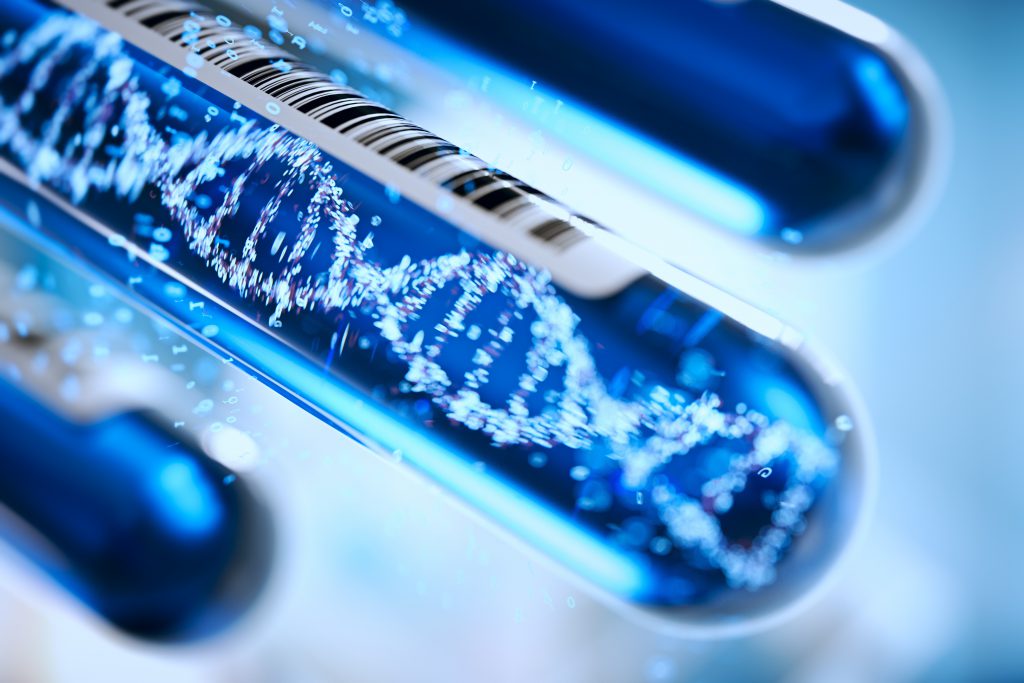
Since May 2018 a genetic test is recommended with the diagnosis of neonatal diabetes to determine the present mutation.15 Thus, glibenclamid is one of 62 active ingredients already approved for personalized medicine.15
Contact Person:
Kristina Schraml (kristina.schraml@biovariance.com)



